The art of dyeing goes back to the Neolithic period. I often wonder how people developed different skills and methods. Some might happen by accident but then on the other hand there are no accidents. It was meant to be.
I was introduced to natural dyes in 1978 while attending a 5 month live in course in sustainability in particular with reference to wind and solar energy, utilising bio gas, growing organic gardens and following a vegetarian diet.
First I learned to spin which was as fascinating as any alchemy in the world transforming a fibre like wool into a thread that could then be knitted, woven, stitched, platted or crochet. I was spellbound and my imagination got on a rollercoaster creating masterpieces in my mind and I could hardly wait to get my hands on some knitting needles.
However the spinning classes were followed up by a 4 days’ workshop on natural dye. I was intrigued and awestruck. I had no knowledge about extracting dye from plants. 13 new doors just opened in front of me. I let myself loose in this beautiful colourful world of plant kingdom.
During the course we went fossicking for and to gather Heather, Oak leaves and bark, Birch leaves and bark, Tansy, Horsetail, Walnut leaves, bark and green husk, Chestnut, Chamomile, St. John’s wort, Lichen, Mugwort and Stinging nettle. The gathering of plant materials in itself was awesome.
It was a great experience to connect with the plant kingdom and my favourite connection was that with the Oak, Walnut and Chestnut tree. They have always been my guides and guardians. I was absolutely flabbergasted by the colours I obtained from the English Oak Quercus robur, Walnut and Chestnut. I could sit for hours and just admire these deep brown and deep green colours. It was like going into a trance or into deep meditation and these colours became my favourites comforting me when I felt confused and lost. The trees took me back to my childhood and teenage memories of gathering nuts, berries and mushrooms in the beautiful forest just out of town. Later in life these trees became my great companions.
Oak is my spirit tree. It is like a totem and you have to remember that my forefathers long time ago were the famous Vikings building long boats out of oak timber. Both Peder and I have had amazing encounters with old trees around the world. I use to go to this special place in Denmark. It was a beautiful old Oak forest near the beach. You could actually say that the Oak trees met and greet the sea. It was so beautiful no matter the season. I often went there to gain knowledge, seek emotional healing and just share and tap into their wisdom. The old Druids used to come here together with the everyday Viking. The very name druid means “oak wisdom”. They would sit under the trees and exchange news from their many journeys. The Hobbits, Goblins, Elves and Gnomes would join in the party and the Druids as well as Vikings were great story tellers and with some accompanied musicians there was no time for big worries. Problems were solved, mead drunk, wild pigs hunted, killed, cooked and eaten. It was a great time like the time I spend in Walhalla. The Druids never wrote anything down and they were considered magicians.
Well, I am coming back to the natural dye before I get completely lost in great stories from the around the world. The beautiful colours obtained from nature followed me all the way to Australia and a new chapter in the journey unfolded. Now was time to learn about completely different plants and trees. Learn the names and try identifying some of them I found it quite difficult and very mesmerizing. Just think about how many species we have growing of Eucalyptus, Myrtle, Melaleuca, Acacia, Banksia, Grevillia and so forth. Lots of experiments have been done. Lots of samples has been filed and many a recipe written on scrap paper. Lots of knowledge gathered and today I am working on new (to me) methods. I am having a lot of fun at the same time sharing my knowledge with people who are willing to learn how to release the gorgeous colours nature is providing us. Through my work with native plants and trees I feel connected to the old ancient continent of Gondwana.
Living in the tropics of Australia there are no English Oak trees around like the ones in Denmark. However, I have bonded with the Casuarina equisetifolia , She–oak native to Australia. I first came across this tree when I was travelling around the country on my own in 1985. A ranger told me that the tree was also call “The Whispering Tree” and if you listen you can hear these trees communicate. I was camping rather close to some of these trees and I woke up in my tent in the middle of the night and had to ask myself: “Did I hear a tree whispering or am I just letting my imagination run wild”? Well, depending on who you are I am sure you have a wild imagination too, but the whispering was real. Trees do communicate with each other and if you listen and have patience you will after a while get to understand what they are all talking about. It is like learning a new language. It is actually amazing what knowledge a tree carries. I read a book not long “The Hidden Life of Trees” by Peter Wohlleben. It is a mighty great book and a great eye opener.
Connecting with this new world, this new land, this new continent, this new life has been a great adventure and still is. Trees on this continent amaze me especially the Eucalyptus family. I always knew from Scandinavia that deciduous trees dropped leaves. To my amazement Eucalyptus keep their leaves and shed the bark instead. How awesome is that! I almost killed myself laughing and knew that this was to be a very special part of my journey in life.
I mainly use leaves, berries, roots and bark to obtain different colours for my yarns and fabrics. A lot of plant materials give some beautiful colours and the dye is set using a so called mordant. Mordant comes from the Latin word “mordere” meaning “to bite”. Typically the dye is extracted by soaking the plant materials then boiling it. Then submerge the fabric or yarns (in this case silk) in the liquid when it is cool at about 35 degrees Celsius. Add some rusty items bring the dye pot to 90 degrees Celsius for 20 minutes. Let cool in dye pot overnight. Squeeze out excess liquid hang in shade to dry. Rinse in lukewarm water with a dash of vinegar. Then wash in gentle wool wash.
A great reminder of wonderful colours is also to be obtained from lots of our so called weeds. Weeds I guess is a name for plants that grows in a place that we don’t appreciate. I call them for wild herbs and such as Blue top, Cobblers pegs, Peruvian hops, Wandering Jew and Japanese sunflower yields great colours. Once emerged in the natural dye you will look at nature from a different perspective. Japanese sunflower is my favourite herb at the moment.
You can’t stop me and at the moment I am mucking around with Eco printing with leaves soaked in rusty water. I have a large bucket which I filled with leaves of all shapes and different colours then I added water. Now was time to go hunting for rusty items. I found lots of stuff in and around Chillagoe, Almaden, in the streets of small townships like Ravenswood. There is always a rusty nail to be found around pioneer places. Rusty bottle tops outside the pub and visiting a tip shop in the outback is like walking into Aladdin’s Cave. I leave the rusty items in the bucket to soak for a week before I start using the leaves for printing. Some of the leaves have been soaked for 3 weeks now and the smell is quite interesting. However it adds another level to the natural dye process. The process activates all your senses. I have no idea what most of the leaves are and I don’t care. One thing I know those high in tannin will give a beautiful print such as Willows, Maples, Wattle, Eucalyptus, Red mangrove, Green tea, Bay leaves, Blackberry leaves, Cherry leaves, Raspberry leaves, Oak leaves, Pecan nut leaves, Horse chestnut, Pine bark, Acorns, Oak galls, Pomegranate rind and lots more.
I must share my Lilly Pilly Syzygium smithii storymember of the Myrtle family and native to Australia. It is such a great tree with an abundance of birdlife as they come to eat the Lilly Pilly berries. You will find visitors like Pied currawong, Satin bowerbird, Australian king parrot, Crimson rosella, Wonga pigeon, White-headed pigeon, Topknot pigeon, Rose-crowned fruit dove and Superb fruit-dove. Of a night time the Lilly Pilly has other visitors such as the Brush tail possum and flying foxes. It is just amazing that a small tree can produce so much food for lots of creatures to munch on.
I was lucky visiting Daintree Village and right there in the middle of this pretty village were two Lilly Pilly trees standing together like two majestic guardians of the River View camp ground. Heaps of red Lilly Pilly berries on the ground neatly put around the base of the trunk. I sought permission to collect the berries and got the “Go Ahead Girl” and so I did. I was asked was I going to make gel, chutney or jam. With a big smile on my face I could tell that I was going to use the berries for dyeing some silk and cotton fabric.
When I got home I fermented the berries and after a very short time in the ferment glass the berries all turned black. You never tire out of the alchemy of the Natural Dye and it is like having a wand in your hand while unwrapping the next natural master piece. You can only wish for a result but you can’t control it. You can have expectations and when they are not met then we get disappointed. So the great art is to leave your expectations up high in a Mulberry tree before you venture into the colourful world of natural dye.
How to ferment your berries, leaves, flowers, beetroot, red cabbage and so forth for natural dye:
Put a layer of your choice of dye material in a glass or ceramic jar. Now add your parcel of silk fabric or cotton. (I make a small parcel with layers of fabric adding some rusty nails and sliced Turmeric tuber). Put another layer of dye material in and make sure the fabric parcel is covered in dye material then add water. The material must be covered in liquid. Put ingredients under pressure (you can sit a glass jar with water on top of the material in the glass or ceramic jar). Have the jar sitting in a tray/dish. When the concoction starts to ferment the liquid will overflow and make a mess on the kitchen table. Keep the jar at room temperature, out of the sun until the fermenting is finished. The fermenting has finished when the brew stops bubbling. Empty the jar and put the fabric parcel somewhere safe to dry up. Do not unpack. Watch what is happening instantly when the parcel gets out of the jar the oxygen will hit the parcel and it will change colours. Just magic, the same magic you will see if you were dyeing with Indigo. After 3-4 days I unpack my parcel.
Keeping a record is a great companion when you travel country. As I progress with my natural dye projects I keep a sample of the colour obtained from each specific plant. I keep this small sample of the colour in a note book and in a separate note book I record all my different recipes. I also pay attention to my observations and write them along with the recipe. For instant when I fermented the Ceylon spinach berries together with the silk fabric which was wrapped with rusty nails and Turmeric the fabric was bright pink as I took it out of the glass jar in which it had fermented. Then the oxygen hit the fabric and it turned deep purple almost black. I was very excited as it is rather seldom that you get black using plant materials for dyeing fibres. The fabric was left out to dry and after app. 30 minutes the fabric decided to turn a greenish/brownish colour. The world is full of stunning surprises. You have to be willing to learn new thinking, techniques and practice. Connect with your inner being. Connect to your inner child hold the feeling and start your natural dyeing process. Trust your inner self and grab hold of any inner reflections fluttering around. Go with the flow and where the wind takes you to distant horizons. To the land of no rules where everything is right and there is no wrong where old boundaries has evaporated into thin air.
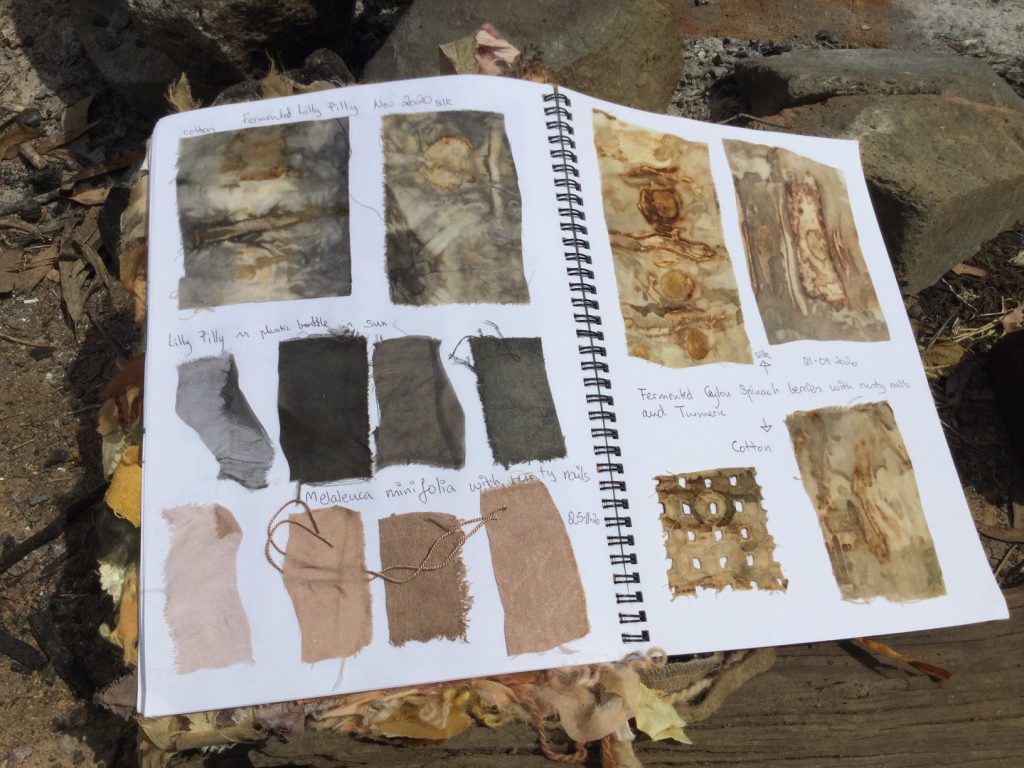
In my early years of natural dye I used a few chemicals to set the dye. The so called mordant such as tin, copper sulphate, iron sulphate and chrome. When I realised that they were quite nasty for the environment I stopped using them. Today I only use alum, cream of tartar, rusty nails, iron and copper pots.
I work on a whim and I am sure that my exposure to craft in many different forms from early childhood has had an influence on how ideas pop up out of the blue. That’s probably why I am mucking around with chook, cow and kangaroo manure at the moment. I ferment it to see what colour I get. It is a smelly business and very interesting. You have to be fearless don’t worry about what your neighbour, friends or family think or say as it has nothing to do with you. It is a unique way of extracting colours; however please remember that this is how it was all done before the industrial revolution, before chemicals were invented.
Natural dye is a lot of fun and you can never predict what you are getting with the method I am using nowadays with wrapping rusty nails and bolts with silky oak leaves, turmeric and purple carrots. It is a great challenge for control freaks to enjoy this art as it is incontrollable.
Some people say that my creativity seems to know no end. It is wild and without boundaries. I am a free spirited person with heaps of wander lust. It is in my DNA. Isn’t that just awesome? My late friend Margaret called me a creative stirrer. She even made me a rune that symbolises this. My friend Megan says that “Ulla infuses herself into every little thing she creates and the result is unique and amazing pieces of art of the mind. Ulla has a joy for living and coming from her heart. Typical for Ulla, why do something ordinary when you can do the extraordinary”?
See me in action in the videos below!
Ulla’s living natural dyeing – creating colour from your garden
Ulla’s natural dye-ing workshop Koah Hall
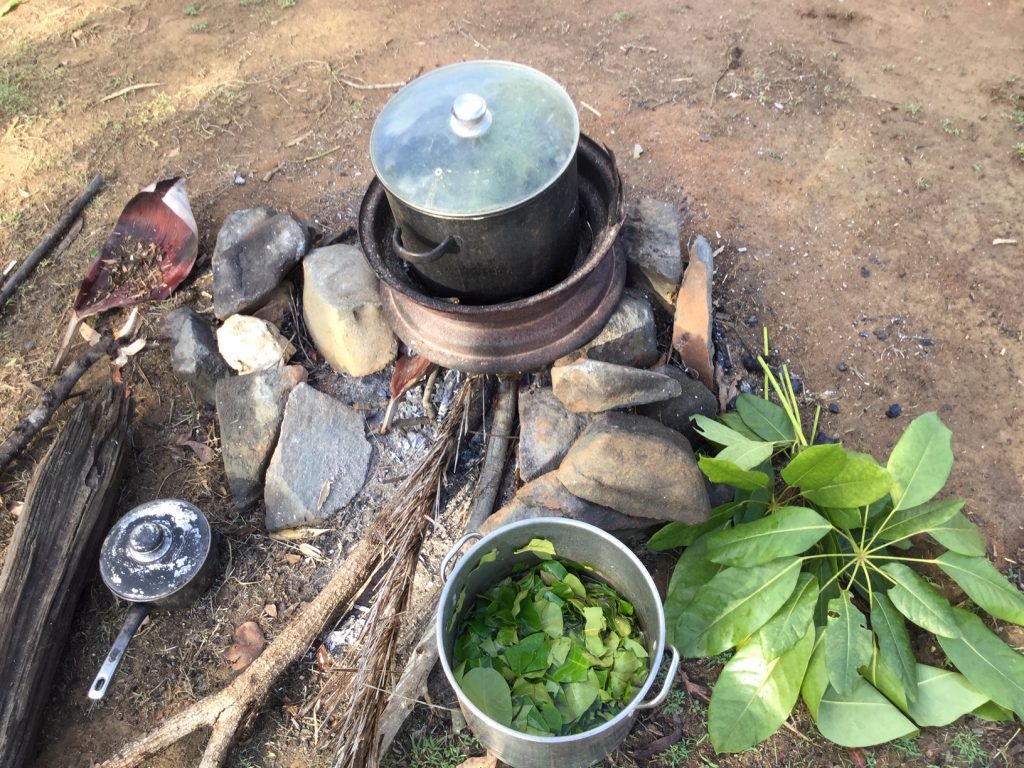

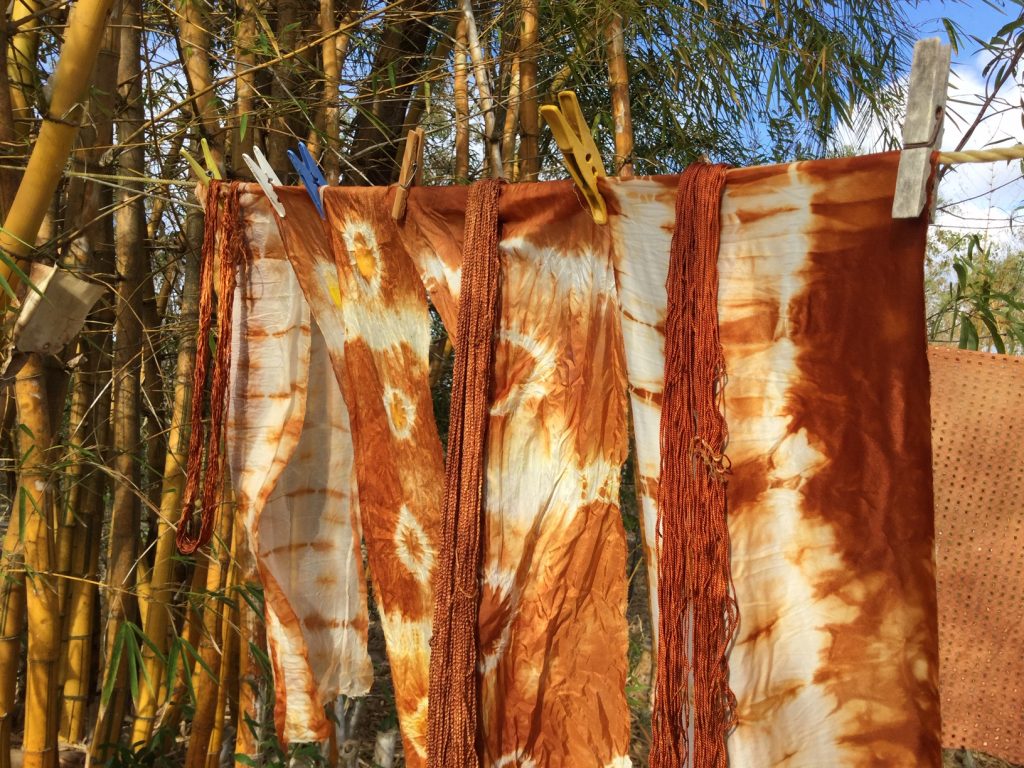
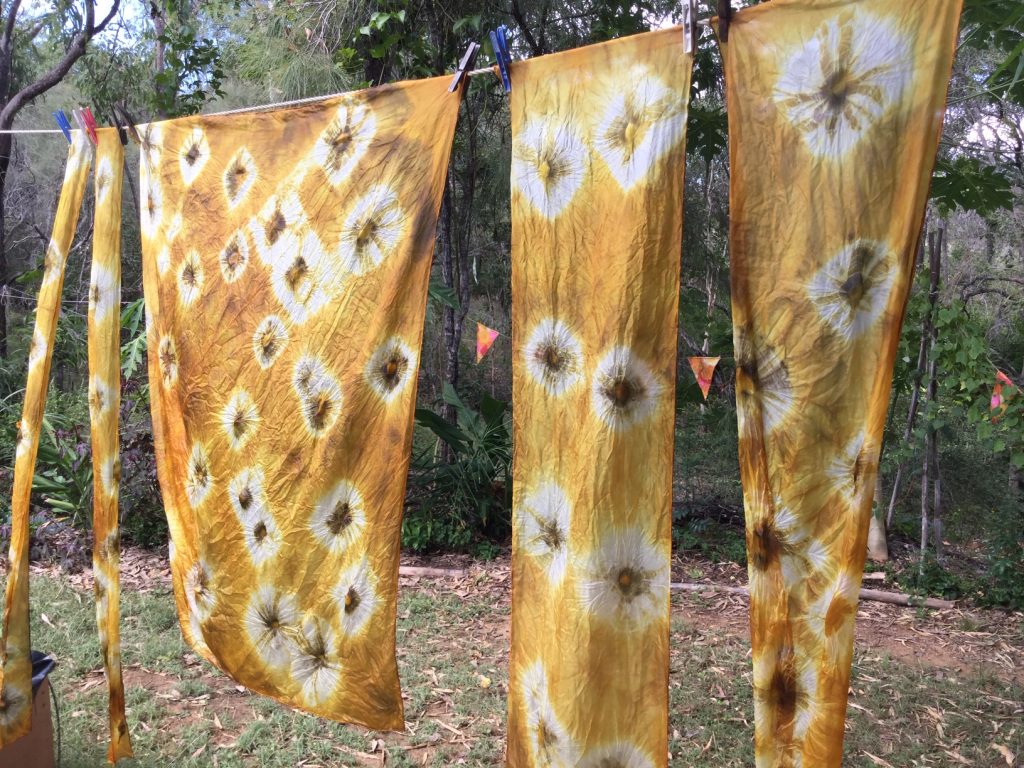
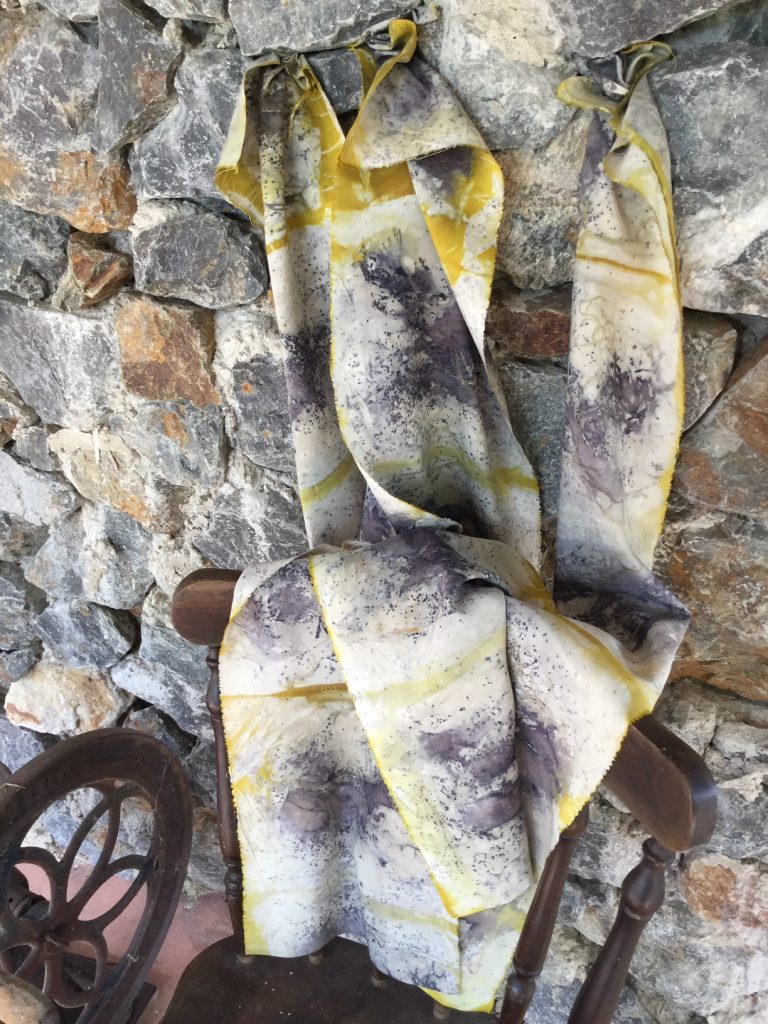

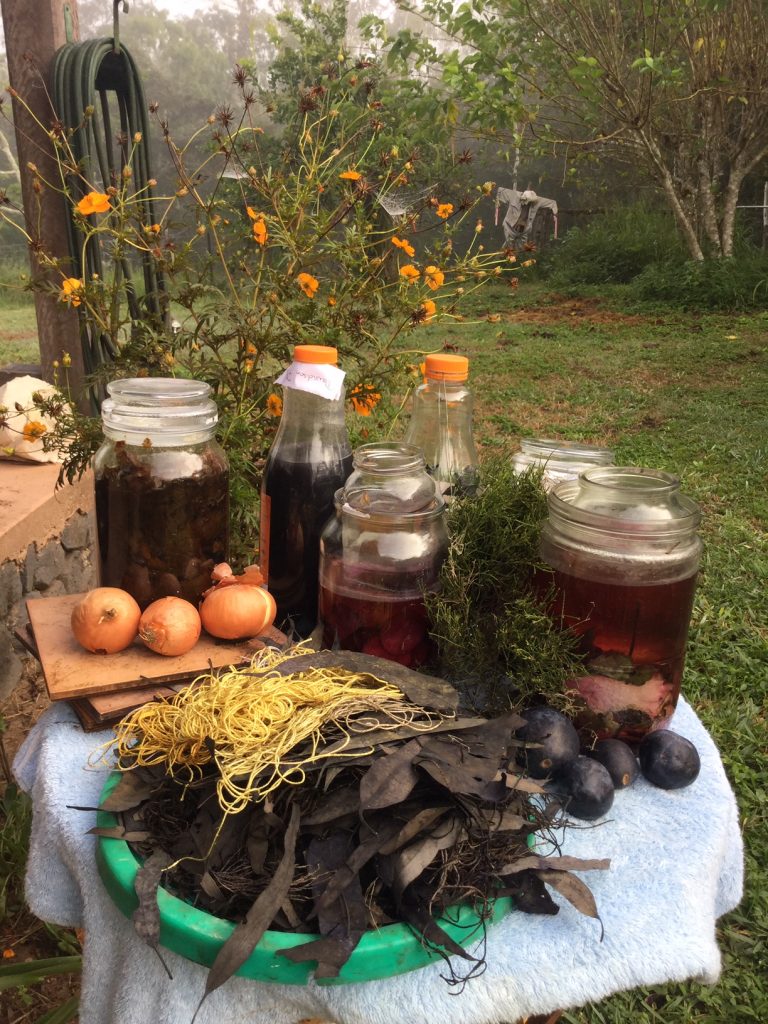
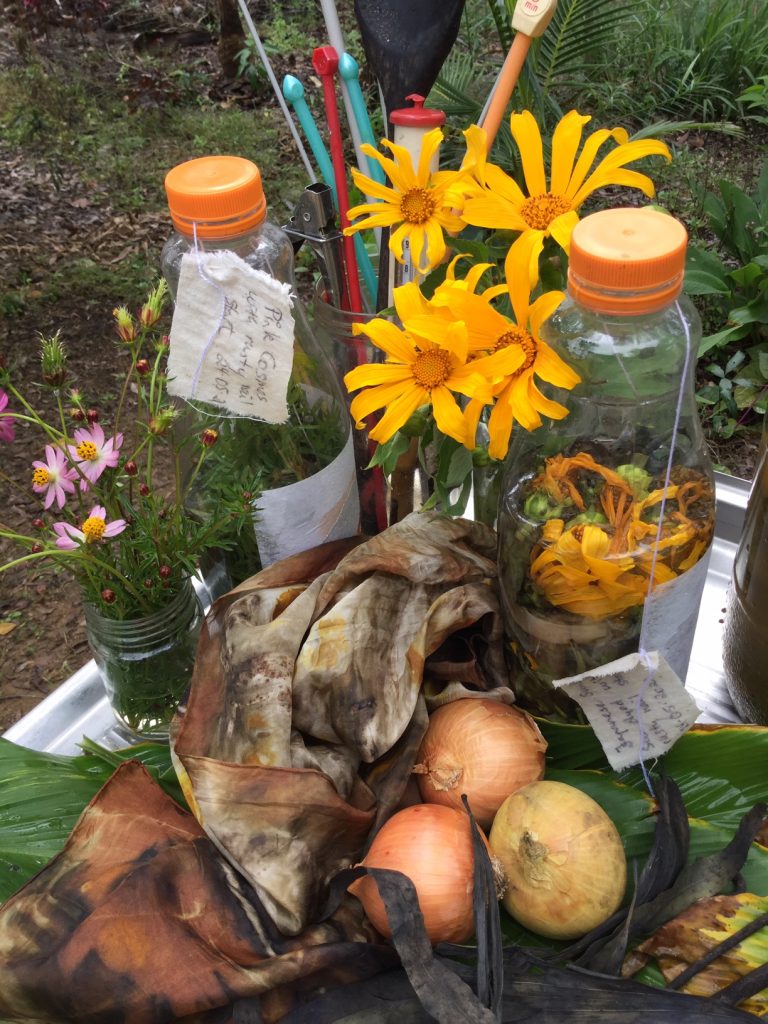

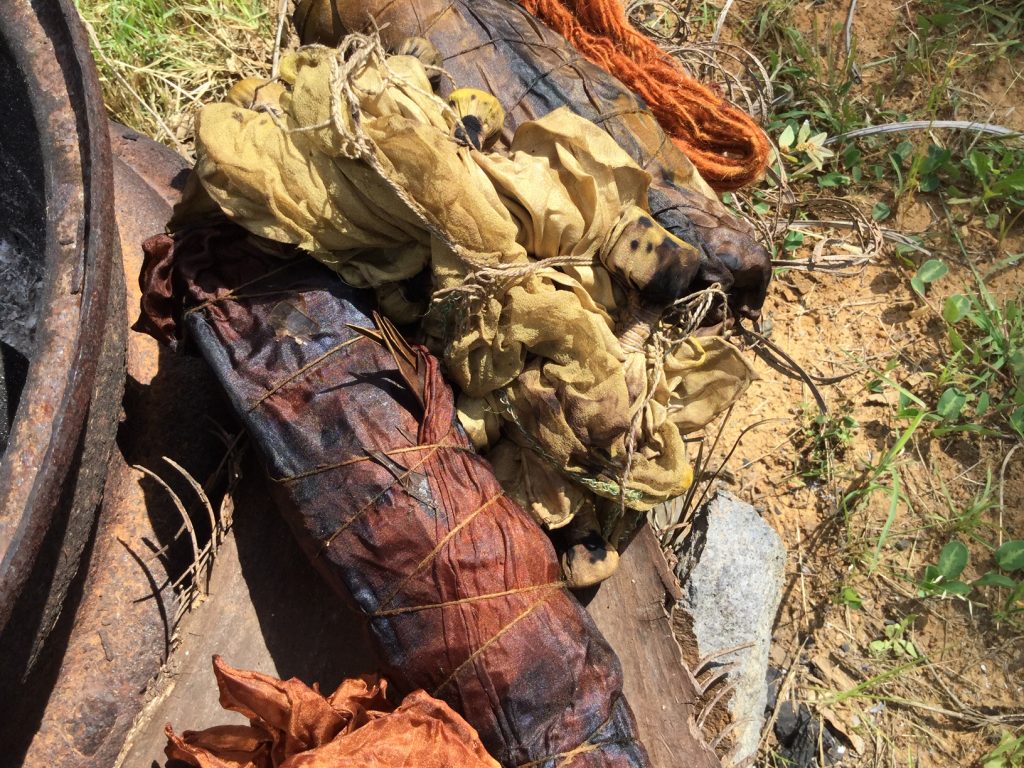
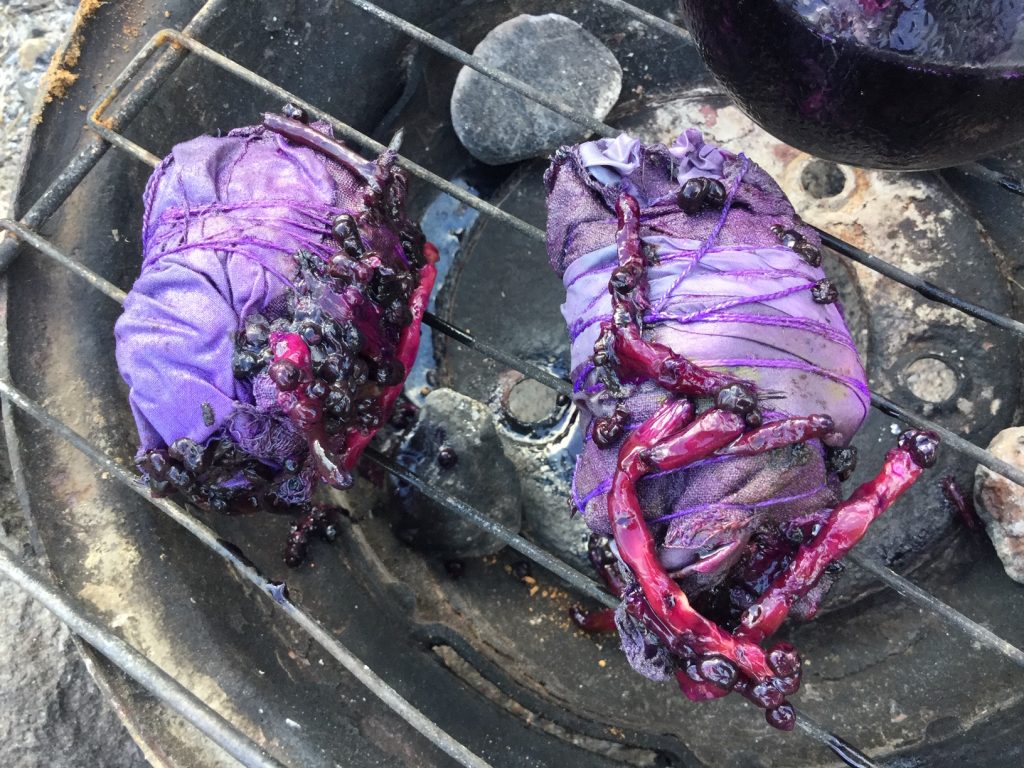



o ulla, you are such a magnificent creative writer, and such a clever creative intuitive amazing craftswoman!! as well as superb gardener and seedsaver!!, thank you so much for bee-ing you!! and for sharing your quite extraodinarily wondrous gifts with us and the world! and thank you for making the world a more beautiful, surprising, creative and delicious place!!!
lovelisa
Wow!! Another wonder-FULL piece of creative writing Ulla!! SO awesome that you are documenting the colours and methods you are creating….future generations will benefit immensely from your tireless desire for investigating new things with Mother Nature’s gifts. A true Alchemist…I feel, and can see, the ancestral strengths from your Viking Mother Line are strong indeed! Your ability to help people open their minds and creative hearts at this time in Her-story, will be having a most wondrous, powerful and positive ripple effect on SO many. Thank You for continuing the amazing story of birthing natural plant medicine in all her forms.
Lots of Love,
Maria xo
So glad to see this wonderful article ‘out there’ Ulla. A truly inspirational contribution for any artisan. And the photography is amazing. Makes me want to leap into them and embrace there wonderful colours and compositions.
Thank you Ulla for a very informative article on natural dyes. Loved the colours and patterns on the materials you dyed in the photos. You are very inspiring with your endless passion for the craft. Lots of love, Lindy.
👍 keep up the good work Ulla…. I‘ve enjoyed already one workshop with you and look forward to the next one as I can see the continuous growing process you are doing… thank you for sharing all your knowledge with us…. Cheers Jutta from Toogoolawa
Hi Ulla,
Another wonderful story. It’s a very interesting topic. My favourite character is the rusty nail. You sure have done a lot of experiments along the way with amazing results. Very beautiful. You always find something that is unique and creative. Much love to you and Peder.
Dear Ulla, I absolutely love reading your stories…they always transport me. I have really loved learning about the natural dyeing, I am so glad it brings you so much colour, excitement and joy.